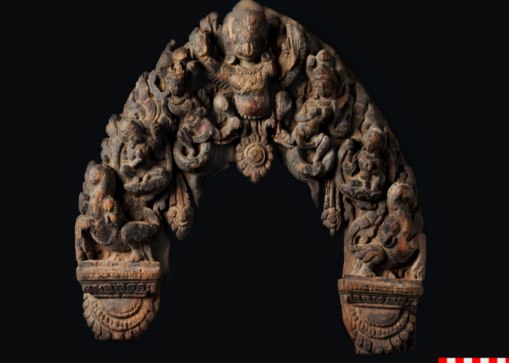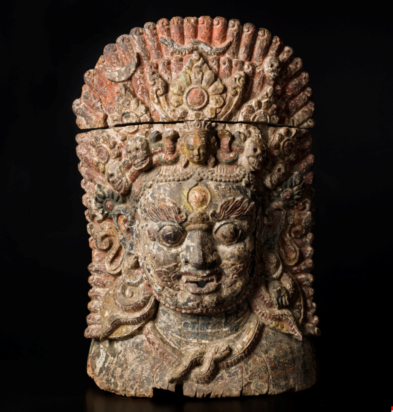
Nepal is a unique field for all branches of scientific studies. This is how Werner Jacobsen enthusiastically begins a letter to the director of the National Museum of Denmark. The year is 1957, and Jacobsen is writing the letter in southern India, where he has spent the previous six years. For ethnographers, in particular, Nepaus
l was indeed a fertile ground for research.
Nepal opened its borders in 1951, after the end of the Rana regime (1854-1950). The population was a patchwork of ethnic groups that lived more or less as their ancestors had done through centuries. Although the social fabric was relatively static in the close-knit society, things were about to change. King Tribhuvan started the democratic experiment, and foreigners and foreign aid began to flow into Nepal.
 An ethnographic wonderland
An ethnographic wonderland
Werner Jacobsen arrived in Kathmandu in June 1957, and he immediately saw possibilities in Nepal. As an archaeologist, he had taken part in an expedition to Mongolia in 1938-39, and then spent almost ten years in India and Sri Lanka during the 1940s and 50s. He traveled independently in India and Sri Lanka, but the National Museum of Denmark in Copenhagen and Moesgaard Museum in Aarhus had commissioned him to collect ethnographic material for their respective collections.
In Nepal, he saw the potential of making a ‘research station’, where Danish scientists of all branches could stay while carrying out their research in the country. Jacobsen set up the Danish Cultural Research Institute in a villa in Kalimati, Kathmandu. This initiative was part of a greater ‘Himalayan initiative’, meant to strengthen Danish research in the region, but the plan never really unfolded. Apart from a few short visits, Jacobsen was the only Dane at the research institute. In 1959, he went back to Denmark—for good.
Upon returning to Denmark, he became a curator at the National Museum of Denmark, where he catalogued his rather substantial material. From 1957-59, he had collected close to 400 objects for the Danish museum collections, taken hundreds of photographs, made documentation of several temples, and acquired a number of texts for the Danish Royal Library. He curated several exhibitions through the 1960s and 70s, in which the material was put on display. Even after his death in 1979, several exhibitions of his outstanding material traveled throughout Denmark.
 Bridging past and present
Bridging past and present
Jacobsen’s collection gives testimony to the life and society that he met in the 1950s. The objects he collected and the photos that he took back then reflect traditional social, cultural, and religious life in Kathmandu Valley, which was on the brink of rapid change. Besides giving testimony to the past, the collection holds—as all museum collections do—a potential to the understanding of contemporary society and life in Nepal.
That is the central idea in a Danish research project, which has reintroduced the objects to a Nepali audience. That was done through the exhibition ‘A Divine Visit – Encounters with the Past’, which visited six different locations in Kathmandu Valley during January 2018. A group of museology students and members of the faculty at Lumbini Buddhist University and me, a Danish PhD student and museum curator, prepared the exhibition, which opened in Patan Museum on January 12, and thereafter, visited Nag Bahal (Patan), ItumBahal (Kathmandu), Jana Bahal (Kathmandu), The Heritage Gallery (Bhaktapur), and the JyapuSamaj (Patan).
The original idea was to bring a selection of nineteen of the artifacts from the Jacobsen collection to Nepal. Due to political circumstances, however, it proved impossible to carry out that plan, and as a consequence, we had to work with photos of the artifacts instead, and a selection of photos taken by Werner Jacobsen in the 1950s. During the display of the exhibition, which consisted of sixteen posters with photos and accompanying texts, the audiences were invited to fill out questionnaires and participate in focus group interviews.
During the fifteen days of display in six locations, there was an overwhelming interest in the exhibition, and although no one had heard about these particular artifacts, collected sixty years ago, there is certainly no doubt that people revered them. A good portion of the artifacts selected for the exhibition have been part of ritual practice in temples, and some of them had been used in private households.
Continuity and change
Besides highlighting the importance of heritage in contemporary Nepal, the exhibition, A Divine Visit – Encounters with the Past’, also reflected upon the changes—and the continuities—that have taken place from the 1950s to this day. Obviously, everyday life in Nepal is undergoing dramatic changes these years, but how fundamental are these changes to be understood?
If Jacobsen went for a walk through the narrow streets of Kathmandu or Patan today, he might have difficulty recognizing the places. The ubiquitous roaring traffic, the mushrooming five-story buildings, and the hectic pace of life would seem a world apart from what he experienced in the 1950s. But, there would still be elements that he would recognize; the many ancient temples, people’s devotion to shrines and festivals, and the omnipresent hospitality of the population would reassure him that this hectic place is, indeed, Kathmandu Valley. In spite of dramatic changes in everyday life, Newari culture continues to put a spell on visitors.
 The importance of heritage
The importance of heritage
When Jacobsen collected the artifacts in the 1950s, there was no such thing as ‘heritage’. The concept of heritage was coined by UNESCO in the 1970s. What he purchased in the three cities of the valley were simply objects, some of which had been a part of ritual life in Nepal until then, or not. The 1960s, 1970s, and 1980s, however, saw a massive outflow of objects from Nepal, which fall under the label of heritage. Two extremely important books published in 1989, by Lain Singh Bangdel and Jürgen Schickl, serve as inventories of objects that were illegally removed from their original place, Nepal.
It is a well-known fact that thousands of objects were stolen and smuggled out of the country in the 1970s and 1980s. Although the intensity of the thefts have slowed down since the 1980s, ancient objects still disappear from temples and public places. After the 2015 devastating earthquake, attention to heritage and its safekeeping has been even more intense than before.
In January, the exhibition also caught the attention of the national media in Nepal. In some newspapers, the opinion was expressed that the objects in the Jacobsen collection ought to be repatriated to Nepal. The coverage showed that the theme of repatriation of cultural heritage to Nepal is a sensitive matter. Many foreign museums, not to mention private collectors, around the world hold artifacts that once were a part of ritual life in Nepal. Should they be repatriated? And if so, on what grounds? These are some of the questions that came up in the research project.

The exhibition, ‘A Divine Visit – Encounters with the Past’, was the outcome of a collaboration between Aarhus University/Moesgaard Museum and Lumbini Buddhist University (LBU). It is curated by a Danish PhD student and museum curator and a group of museology students and members of the faculty of LBU.
About the author: Ulrik Høj Johnsen is currently working on his PhD dissertation, “Reassessing the Value of a Museum Collection from Nepal”, and is also curator in Moesgaard Museum Denmark. He has carried out fieldwork in Nepal in 2017/18.










